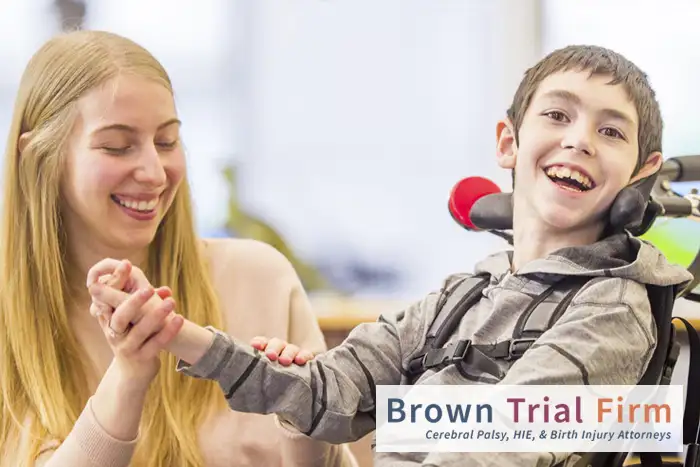When a child is diagnosed with cerebral palsy (CP) or hypoxic-ischemic encephalopathy (HIE), it can bring a tidal wave of worry and uncertainty to a family, leaving you with many questions about the future and how to best support your child. In such cases, understanding the potential cause of your child’s condition is critical, particularly if you suspect that it may be the result of a medical mistake made before, during, or immediately after birth.
Nebraska birth injury attorney Laura Brown is deeply committed to assisting families affected by birth injuries like cerebral palsy and HIE. With empathy at the core of her practice, Laura provides the expertise and support necessary to navigate the complex landscape of birth injury law.
Laura and her team are dedicated to helping you uncover answers and will advocate vigorously to ensure that your family gets the compensation and support needed to help your child grow and thrive.
Get started today by scheduling a free consultation to learn more about your legal rights and options in Nebraska.
What is cerebral palsy?
Cerebral palsy is a neurological disorder that affects muscle tone, movement, and motor skills. It’s caused by brain damage or abnormalities in brain development, which can occur before, during, or shortly after birth.
The condition results in impaired coordination and muscle control, which can impact a person’s ability to walk, maintain balance, and perform fine motor tasks, even making eating and swallowing difficult for some people.
The severity of cerebral palsy varies widely; some individuals may experience mild symptoms and require minimal assistance, while others may have significant physical disabilities and need extensive lifelong care.
What is the most misunderstood thing about cerebral palsy?
Learn the truth about the top 10 misconceptions and myths regarding cerebral palsy.
What is the most common cause of cerebral palsy?
Oxygen deprivation (hypoxia) during childbirth is a major cause of brain damage in infants, often leading to serious conditions like hypoxic-ischemic encephalopathy (HIE) and periventricular leukomalacia (PVL). HIE occurs when the brain receives insufficient oxygen or blood flow, while PVL specifically involves damage to the brain’s white matter due to similar issues. Both conditions are significant risk factors for developing cerebral palsy (CP), as they can affect areas responsible for motor control and coordination.
Common causes of oxygen deprivation that can result in HIE, PVL, and ultimately cerebral palsy include:
- Problems with the umbilical cord. Umbilical cord issues, such as a prolapse, knot, or cord wrapped around the baby’s neck, can severely restrict blood flow and oxygen to the baby.
- Placental complications. Issues like placental abruption (where the placenta detaches from the womb too early) or placental insufficiency (where the placenta fails to deliver enough oxygen and nutrients) can lead to oxygen deprivation.
- Long or difficult labor. Extended labor or complications during delivery can stress the baby’s oxygen supply, particularly if there are delays in performing a necessary cesarean section (C-section).
- Maternal blood pressure issues. Conditions such as preeclampsia can affect blood flow to the placenta and thus reduce oxygen supply to the fetus.
When the brain is deprived of oxygen, even for a short period, it can lead to cell damage that disrupts normal brain development and leads to cerebral palsy. Managing and preventing oxygen deprivation through careful monitoring and timely intervention during labor and delivery is crucial to reducing the risk of HIE and cerebral palsy.
In addition to oxygen deprivation, other common causes of brain damage leading to cerebral palsy include:
- Premature birth, where the brain is not fully developed due to the baby being born too early, increasing the vulnerability to brain damage.
- Infections during pregnancy that reach the fetus and disrupt normal brain development, such as rubella, cytomegalovirus, or toxoplasmosis.
- Stroke in the womb, which occurs when there is a disruption in blood flow to the developing brain, leading to brain damage.
- Improper use of delivery instruments like vacuum extractors or forceps, which can directly damage a child’s brain.
- Untreated or mismanaged kernicterus, which is a severe form of jaundice in a newborn that can lead to brain damage.
While not all of these conditions are preventable, if they result from a doctor or other health care provider’s failure to meet the expected standard of medical care, it may constitute medical negligence, potentially entitling the affected family to pursue legal action for compensation on behalf of their child.
What is the best treatment for cerebral palsy?
The best treatment for cerebral palsy varies depending on the individual’s specific symptoms and needs but generally involves a combination of therapies to manage and improve motor functions, communication, and overall quality of life.
These treatments may include:
- Occupational therapy. Assists with daily activities and improves independent living skills.
- Speech therapy. Aims to enhance communication abilities and address swallowing difficulties.
- Assistive technologies. Devices like walkers, wheelchairs, or communication aids can enhance independence and mobility.
- Physical therapy. Helps improve strength, mobility, and posture.
- Medications. Used to manage muscle spasms, pain, and sometimes seizures.
- Surgery. Can be useful for correcting physical deformities, reducing muscle tightness, and improving mobility and overall function.
Can surgery fix cerebral palsy?
Surgery cannot cure cerebral palsy, as CP results from irreversible brain damage. However, specific surgical procedures can help manage some of the symptoms associated with CP. For instance:
- Orthopedic surgery can correct anatomical abnormalities and improve mobility and function, such as by lengthening tight muscles and tendons to reduce spasticity.
- Selective dorsal rhizotomy (SDR) is a neurosurgery that selectively cuts problematic nerve roots in the spinal cord to relieve muscle tightness and improve mobility.
Treatment for CP often requires a multidisciplinary approach involving multiple specialties to address the physical, cognitive, and emotional needs of the individual and improve their overall quality of life.
Do I need a Nebraska cerebral palsy attorney to help with my claim?
In most cases, the answer is yes. A Nebraska cerebral palsy attorney can be a valuable asset in navigating the complexities of a claim if you believe your child’s cerebral palsy or HIE was caused by medical negligence.
Here’s how they can help:
- Review medical records. Your attorney will meticulously examine your child’s medical records from pregnancy, labor, and delivery to identify any potential red flags that might suggest a deviation from the accepted standard of care.
- Consult with medical experts. They can collaborate with medical professionals specializing in obstetrics, neonatology, or other relevant fields to analyze the medical records and provide expert opinions on whether negligence might have played a role.
- Negotiate with insurance companies. The insurance companies representing medical professionals typically try to minimize payouts. An attorney has the experience and knowledge to negotiate aggressively for the compensation your child deserves.
- Build a strong case. By gathering evidence and expert opinions, your attorney will work to build a compelling case that demonstrates a link between medical mistakes and your child’s CP diagnosis.
- Provide trial representation (if necessary). In some cases, the claim might require going to court. Your attorney will represent you in court, presenting evidence and advocating for your child’s rights.
- Maximize compensation. Cerebral palsy often requires ongoing medical care, therapy, and equipment. Your attorney will fight to recover compensation for past and future medical expenses related to your child’s CP, as well as lost earning capacity, pain and suffering, and decreased quality of life.
Remember, medical institutions and insurance companies have experienced legal teams, and so should you. Having a birth injury attorney on your side ultimately levels the playing field and increases your chance of a successful claim.
Nebraska cerebral palsy resources for children and families
For families in Nebraska dealing with cerebral palsy or HIE, several resources offer specialized support, therapy, and advocacy to help manage these conditions and improve quality of life. Here are a few key organizations across the state:
United Cerebral Palsy of Nebraska
This organization offers resources, support, and advocacy for individuals with cerebral palsy and their families. They provide information on therapy options, funding assistance, and educational programs.
- Address: 11930 Arbor St, Suite 202, Omaha, NE 68144
- Phone: (402) 502-3572
Part of the University of Nebraska Medical Center, this institute offers a range of services, including physical therapy, occupational therapy, speech therapy, and psychological services specifically designed for children with developmental disorders like cerebral palsy.
- Address: 6902 Pine St, Omaha, NE 68106
- Phone: (402) 559-6418
Provides comprehensive services, including early intervention, pediatric rehabilitation, and family support services for children with disabilities, including cerebral palsy.
- Address: 12565 W Center Rd, Suite 100, Omaha, NE 68144
- Phone: (402) 462-3031
Get your child the compensation they need and deserve with the help of an experienced Nebraska birth injury attorney
Secure the compensation your child needs and deserves with the guidance of Laura Brown, an experienced Nebraska birth injury attorney at Brown Trial Firm.
Specializing in cases involving cerebral palsy and hypoxic-ischemic encephalopathy, Laura understands the challenges your family faces and is dedicated to helping you navigate the complexities of your child’s birth injury claim so you can access vital resources for medical care, rehabilitation, and lifelong support.
Reach out to Brown Trial Firm today to schedule a free consultation and take a crucial step toward advocating for your child’s rights and securing their future.



